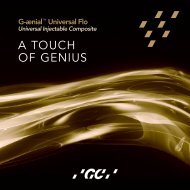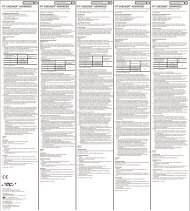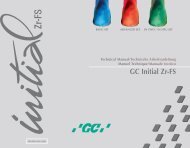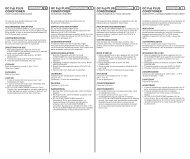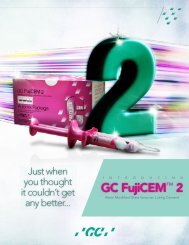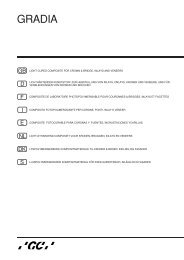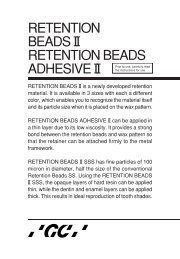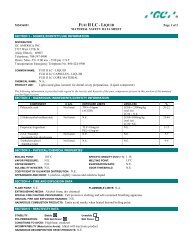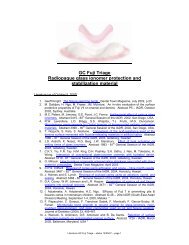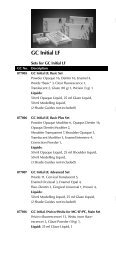Psychological Impact of Communication - GC America
Psychological Impact of Communication - GC America
Psychological Impact of Communication - GC America
Create successful ePaper yourself
Turn your PDF publications into a flip-book with our unique Google optimized e-Paper software.
<strong>Psychological</strong> <strong>Impact</strong><br />
<strong>of</strong> <strong>Communication</strong><br />
Patient is a 47 year old female was unhappy<br />
with her smile and self conscience <strong>of</strong> her<br />
appearance. She is missing teeth, which<br />
was impinging during mastication. The treatment<br />
plan included sealing and root planning, along with<br />
orthodontic therapy to manage the spaces and to align<br />
the teeth in proper centric relation (Fig 1).<br />
The patient underwent comprehensive examination<br />
and evaluation. FMX, Models, face bow, centric<br />
relation bite, s<strong>of</strong>t and hard tissue exam, TMJ exam,<br />
cancer screening, and periodontal analysis.<br />
After the orthodontic treatment was completed<br />
(Fig 2), a new set <strong>of</strong> study models were taken and a<br />
stick bite in centric relation were taken. The models<br />
were articulated and a LSK treatment plan wax up<br />
was completed by the dental laboratory. The wax up<br />
was used to provide anterior guidance and cuspid<br />
disclussion.<br />
The patient agreed to the treatment plan <strong>of</strong> full<br />
mouth reconstruction and was appointed to have her<br />
teeth prepared in one visit (Fig 3 & 4).<br />
Fig 1. Initial view <strong>of</strong> vertical disharmony and facial analysis<br />
Fig 2. Teeth shape and size can suggest the ideal proportions for the<br />
restorations<br />
Fig 3. Maxillary preparation is completed.<br />
Fig 4. Mandible preparation is completed.<br />
Spectrum Dialogue 1 Vol. 6 No.2
TEMPORIZATION<br />
Stone models were made using the LSK treatment<br />
plan wax up as a matrix and clear stents were<br />
fabricated. Exacta temp xtra (shade A1) was used<br />
for the temporaries. The margins were trimmed; the<br />
contour and the esthetic were evaluated. The bite was<br />
adjusted into Centric Relation occlusion and it was<br />
confirmed. The upper and lower temporaries were<br />
each sectioned into 3 pieces.<br />
Fig 5. The models are mounted on articulator by doctor, the doctor<br />
can compare to what is seen in the mouth.<br />
Impregum impressions were taken and Exacta<br />
Bisacryl temporaries were made. A 2 cord technique<br />
for retraction was used for the impressions. Ultradent<br />
Ultra Pac #00 cord was soaked in Astringe dent and<br />
lightly blotted dry. The cord was lightly pushed into<br />
the sulcus and the teeth were reprepared after the #00<br />
retraction. Ultra Pac #1 was soaked in astringe dent<br />
blotted dry and was placed around all the prepared<br />
teeth. Any excess tissue that was lying on the margins<br />
<strong>of</strong> the prepared teeth was removed with a Parkell<br />
semimatic ilictrosurge 500SE. Areas <strong>of</strong> residual<br />
bleeding were scrubbed with a small cotton pledget<br />
soaked in Astringindent. The preparations were rinsed<br />
with water, scrubbed with a clean cotton pledjet to<br />
remove any debris from the preparation, rinsed and<br />
lightly dried. When all margins were clearly visible<br />
and clean the #1 cord was removed (making sure the<br />
cord was wet when removing), the preparations were<br />
rinsed again and dried.<br />
Permadyne Garant (a light body polyether) was<br />
injected around the margins <strong>of</strong> the prepared teeth.<br />
Air was directed to thin out the material at the<br />
margin and to make sure that all the margins were<br />
coated. Permadyne Garant was then injected over<br />
the preparations and a stock bite sani-tray that had<br />
been painted with 3M ESPE ployether adhesive was<br />
loaded with Permadyne Penta H and placed over the<br />
prepared teeth. The tray was left undistrurbed for 5<br />
minutes.<br />
TAKING THE BITE AND ARTICULATION<br />
The anterior segments are placed onto the maxillary<br />
and mandible preparations. Futar D (Kettenbach<br />
dental) was injected onto the posterior teeth and the<br />
patient bit down into centric relation. After the Futar<br />
D set, the bites were removed and the anterior temps<br />
were removed. The posterior temps were placed and<br />
the bite was verified. Futar D was injected onto the<br />
anterior preparations and the patient was guided<br />
into centric relation until the posterior teeth were<br />
in contact. The upper temporaries were then placed<br />
onto the maxillary preparations and a new bite was<br />
taken <strong>of</strong> the upper temporaries to power posterior<br />
preparations. After the bite setup, the lower posterior<br />
temporaries were placed and the anterior prepared<br />
teeth were registered against the upper temporaries.<br />
The temporaries were then cleaned and cemented<br />
with Zone temporary cement (non-eugenol) (Dux<br />
dental).<br />
The temporaries were cleaned at the margins and<br />
the #00 cord was removed. A stick bite was taken<br />
<strong>of</strong> the midline and horizontal using 6” wooden<br />
sticks. Upper and lower alginates were taken <strong>of</strong> the<br />
temporaries and poured up in vel-mix stone.<br />
The upper temporary model was articulated on a<br />
KAVO articulator using the stick bite impression for a<br />
guide <strong>of</strong> placement. The lower model was articulated<br />
against the lower using a bite. The die model <strong>of</strong> the<br />
lower was articulated against the upper temporary<br />
model. The upper die model was articulated against<br />
the lower die model (Fig 5).<br />
Spectrum Dialogue 2 Vol. 6 No.2
DENTAL LAB PROCEDURES<br />
LSK full colored treatment plan wax-ups with<br />
frame support were completed on the maxillary (Fig<br />
6). The full colored wax-ups were checked in the<br />
mouth and necessary correction were completed (Fig<br />
7). This will let the dental technician establish the<br />
bite for the mandible.<br />
It was decide to use Kavo Everest Zirconia (Fig<br />
8) on the mandible and Porcelain to Metal on the<br />
Maxillary. The Kavo Everest Zirconia single copings<br />
were completed for 22 through 29 and a 3 unit<br />
Zirconia bridge for 18–20. <strong>GC</strong> Initial Zi porcelain<br />
was applied on the Zirconia framework (Fig 9).<br />
The porcelain build up was built to full contour and<br />
included tooth morphology and anatomy. After the<br />
first firing the porcelain was examined for contour<br />
and proper firing temperature (Fig 10).<br />
Fig 6. LSK 121 full colored treatment plan wax-ups with a frame for<br />
support, to be used to try in mouth.<br />
Fig 7. Necessary corrections can easily be made by means <strong>of</strong> full<br />
color wax-up by trying in the mouth, #8 will need to be increase in<br />
height.<br />
Fig 8. The framework is made using the Kavo Everest Zirconium.<br />
Fig 9. The framework has <strong>GC</strong> Initial ZR porcelain applied.<br />
Fig 10. After firing the porcelain, the buccal contour is examined and<br />
the correct temperature <strong>of</strong> the porcelain is confirmed.<br />
Spectrum Dialogue 3 Vol. 6 No.2
The mandible porcelain fired restorations<br />
occlusion is checked using the full colored wax ups<br />
on the maxillary (Fig 11). By using red marking<br />
paper the bite is checked, the relationship to the<br />
maxillary wax ups (Fig 12) and the lower porcelain<br />
to Zirconia restorations (Fig 13) is examined. The<br />
final modification <strong>of</strong> the restorations is completed,<br />
checking the interproximal contacts and three<br />
dimensional line images (Fig 14). The restorations are<br />
finished (Fig 15) and ready for try-in. The maxillary<br />
metal framework is completed (Fig 16) and prepared<br />
for opaque.<br />
Fig 11. The Maxillary is a LSK 121 full colored wax-up and the bite<br />
is checked with the lower Zirconium restorations, after the first bake.<br />
Fig 12. The colored wax-up occlusion pattern is checked from the red<br />
marking paper.<br />
Fig 13. Occlusion is checked <strong>of</strong> the Kavo Everest restorations on the<br />
mandible.<br />
Fig 14. Red pencil lines show proper interproximal contacts and<br />
black pencil lines show three dimensional line images from lower<br />
teeth in bisque bake stage<br />
Fig 15. Finished Kavo Everest with <strong>GC</strong> Initial ZR porcelain<br />
Fig 16. Maxillary metal frame design is checked on the solid model.<br />
Spectrum Dialogue 4 Vol. 6 No.2
The finished mandible lower restorations and<br />
full colored wax ups are tried in the mouth. The<br />
dentist is able to check the cusp-fossa relationship<br />
(Fig 17). The full colored wax-ups are examined for<br />
contour and lip support (Fig 18). If any adjustments<br />
are needed, it is easy to change the wax. The metal<br />
framework can be tried in the mouth with the wax<br />
ups in, this will enable to check room available and<br />
framework design (fig 19).<br />
Fig 17. Maximum cusp-fossa relationship between the LSK 121 full<br />
colored wax-up and lower final restorations<br />
Fig 18. Lip support is checked using the full color wax-ups<br />
The case is returned to the dental laboratory and<br />
the technician can do final checks on the framework<br />
(Fig 20). The LSK full colored wax up is used during<br />
the porcelain application to assure proper contour<br />
(Fig 21).<br />
Fig 19. Opaque coping next to the full color wax-up. This will enable<br />
to check room available and framework design.<br />
Fig 20. Opaqued framework with LSK Treatment Plan Wax-up<br />
before porcelain application and check framework design<br />
Fig 21. <strong>GC</strong> Initial MC Porcelain is used for build-up. The full colored<br />
wax-up are left in place to assure proper contour <strong>of</strong> build-up.<br />
Spectrum Dialogue 5 Vol. 6 No.2
After the firing <strong>of</strong> the porcelain the contour is<br />
checked with the full colored wax up on the master<br />
model (Fig 22). The restorations can be interchanged<br />
with the full colored wax ups (fig 23). The final<br />
restorations are checked (Fig 24) and ready for<br />
delivery to the dental <strong>of</strong>fice (Fig 25). The surface<br />
texture is checked in the mouth (Fig 26) and a natural<br />
appearance is achieved. The lip support and contour<br />
<strong>of</strong> the restorations are checked (Fig 27). The patient<br />
is pleased with the appearance, before she had<br />
discoloration (Fig 28) compared to harmony (Fig 29).<br />
Some areas <strong>of</strong> the patients mouth was missing teeth<br />
(Fig 30), she no longer will have trouble mastication<br />
(Fig 31).<br />
CEMENTATION<br />
After the temporaries were removed and the teeth<br />
were pumiced, cleaned and dried. The restorations<br />
were tried in and evaluated for color, contour, texture,<br />
bite and proper esthetic harmony to the patients face<br />
(Fig 32). The restorations were cemented with <strong>GC</strong><br />
Fuji Cem. The patient had a recall appointment a<br />
week later to re-evaluate the occlusion (Fig 33).<br />
Fig 22. After the first firing, the crown #8 contour is checked to #7,<br />
9, and10-full colored wax-ups<br />
Fig 23. The LSK 121 full colored wax-ups (#3,6,8) and PFM crowns<br />
(#5,7,9) are checked on the master cast.<br />
Fig 24. Finished restorations; upper-porcelain to metal crowns and<br />
bridge, lower-Kavo Everest Zirconia crowns and bridge.<br />
Fig 25. Immediate view <strong>of</strong> final restorations.<br />
Fig 26. Rigth side view <strong>of</strong> occlusion.<br />
Fig 27. Mandible Zirconia restorations<br />
Spectrum Dialogue 6 Vol. 6 No.2
Fig 28. Pre-op right side view<br />
Fig 29. A Post-op right side view, patient desired no black triangles<br />
Fig 30. Pre-op left side view<br />
Fig 31. Post-op left side view<br />
Fig 32. Facial view <strong>of</strong> the restorations shows the suitability <strong>of</strong> the reestablished<br />
incisal length and 3-Dimensional appearance.<br />
Fig 33. The successful integration <strong>of</strong> the restorations and the radiating<br />
symmetry is re-established.<br />
Abou t the author<br />
Luke Kahng, CDT, is the founder and owner <strong>of</strong> Capital Dental<br />
Technology Laboratory, Inc. its division, LSK 121, provides highly<br />
personalized custom cosmetic work. He is also the <strong>of</strong>ficial clinician for<br />
G.C. <strong>America</strong> and Bisco. He is an advisory board member <strong>of</strong> Spectrum<br />
Dialogue and has published articles in Journal <strong>of</strong> Esthetic and<br />
Restorative Dentistry, Practical Procedures and Aesthetic Dentistry,<br />
The Journal <strong>of</strong> Cosmetic Dentistry, QDT Book, Dental Dialogue,<br />
Spectrum and Contemporary Esthetics.<br />
He developed the LSK 121 Treatment Plan, which incorporates<br />
a Wax-Up technique that focuses upon a biomechanical design <strong>of</strong><br />
occlusal surfaces for reconstructive and esthetic dentistry. He has also<br />
developed a series <strong>of</strong> shade conversion table for porcelain.<br />
* Case courtesy Kaz M. Zymantas, DDS, Naperville, IL<br />
Spectrum Dialogue 7 Vol. 6 No.2



